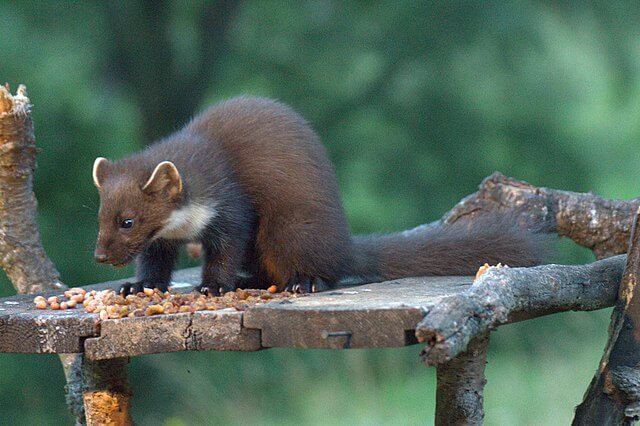
In the less glamorous realm of research, Johnny Birks and John Martin study pine martens’ viability in productive timber forests.
Each autumn, they return to Dumfries and Galloway’s Forest of Ae and Castle O’er to count poo.
The numbers of droppings are increasing which, in turn, shows that the population of the protected species is making “encouraging” progress.
Managed by Forestry and Land Scotland (FLS), these plantations churn out over 120,000 tonnes of timber yearly while increasingly sheltering pine martens.
Research now explores whether artificial dens, offering elevated safe havens for resting and breeding, can further bolster the population.
The goal is to demonstrate whether the pine marten and the lucrative timber industry can coexist.
“Productive forests provide the UK with timber, which is vital, but they’re also home to a variety of species,” Mr Birks said.
In collaboration with FLS, Birks and Martin installed 50 dens in the Forest of Ae in 2020 for comparative analysis with Castle O’er, where none were placed.
Their method involves meticulously tallying droppings, some of which undergo DNA analysis for validation – a task demanding keen expertise.
“We use pine marten scats as a proxy for population establishment,” explained Mr Martin.
“It’s a basic survey method but it indicates population growth or decline.
“It’s important you can distinguish between pine marten and fox scat – it wouldn’t be obvious to a beginner but do enough of these surveys and it becomes easy to differentiate between them, with DNA confirmation as a crucial back-up.”
Initial findings from last year are promising.
“Both plantations showed an encouraging increase in the abundance, density and spread of likely marten scats,” Mr Martin said.
“Our DNA results also showed that the species is continuing to establish in both forests.
“Forest of Ae, which has artificial dens, is still leading the way, with 50 scats compared with 15 in Castle O’er.”
However, he said it was too soon to jump to conclusions about the reasons for that difference.
“Although it’s tempting to attribute the greater numbers at Ae to the artificial dens, the population at O’er could be lagging simply because pine martens started establishing there a year or so later,” he added.
Bill Coombes, FLS’s regional environment advisor, stresses their commitment to harmonising timber production with native species support.
“Trees in plantations tend to be quite young, and so don’t have the cavities that pine marten like to rest and breed in,” he said.
“We are therefore managing our forests to retain some areas of older trees and some windblown areas, as well as some dead trees which will provide potential areas for the pine martens to use.
“These retained areas also provide suitable habitats for a range of flora and fauna as they develop.”
With the pine marten being a natural predator of grey squirrels, the FLS is also adding more artificial dens across the country to help boost red squirrel numbers.
“We hope the marten populations continue to grow, and of course, people are very welcome to visit our forests to spot them for themselves,” Mr Coombes added.
——————————————————————————
At Natural World Fund, we are passionate about stopping the decline in our wildlife.
The decline in our wildlife is shocking and frightening. Without much more support, many of the animals we know and love will continue in their decline towards extinction.
When you help to restore a patch of degraded land through rewilding to forests, meadows, or wetlands, you have a massive impact on the biodiversity at a local level. You give animals a home and food that they otherwise would not have had, and it has a positive snowball effect on the food chain.
We are convinced that this is much better for the UK than growing lots of fast-growing coniferous trees, solely to remove carbon, that don’t actually help our animals to thrive.
This is why we stand for restoring nature in the UK through responsible rewilding. For us, it is the right thing to do. Let’s do what’s right for nature!
Donate today at https://naturalworldfund.com/ and join in the solution!

